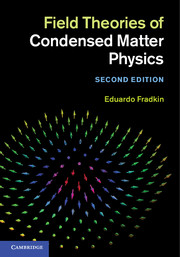Book contents
- Frontmatter
- Contents
- Preface to the second edition
- Preface to the first edition
- 1 Introduction
- 2 The Hubbard model
- 3 The magnetic instability of the Fermi system
- 4 The renormalization group and scaling
- 5 One-dimensional quantum antiferromagnets
- 6 The Luttinger liquid
- 7 Sigma models and topological terms
- 8 Spin-liquid states
- 9 Gauge theory, dimer models, and topological phases
- 10 Chiral spin states and anyons
- 11 Anyon superconductivity
- 12 Topology and the quantum Hall effect
- 13 The fractional quantum Hall effect
- 14 Topological fluids
- 15 Physics at the edge
- 16 Topological insulators
- 17 Quantum entanglement
- References
- Index
14 - Topological fluids
Published online by Cambridge University Press: 05 March 2013
- Frontmatter
- Contents
- Preface to the second edition
- Preface to the first edition
- 1 Introduction
- 2 The Hubbard model
- 3 The magnetic instability of the Fermi system
- 4 The renormalization group and scaling
- 5 One-dimensional quantum antiferromagnets
- 6 The Luttinger liquid
- 7 Sigma models and topological terms
- 8 Spin-liquid states
- 9 Gauge theory, dimer models, and topological phases
- 10 Chiral spin states and anyons
- 11 Anyon superconductivity
- 12 Topology and the quantum Hall effect
- 13 The fractional quantum Hall effect
- 14 Topological fluids
- 15 Physics at the edge
- 16 Topological insulators
- 17 Quantum entanglement
- References
- Index
Summary
In this chapter we will develop the effective-field theory of topological fluids, focusing on the fractional quantum Hall states as the prototype.
Quantum Hall fluids on a torus
Quantum Hall states are topological electron fluids whose properties depend on the topology of the surface on which the electrons are bound. In this section we will discuss the case of a fluid confined to a 2D torus. Although considering a 2D electron gas on a torus is of little experimental value, it is a great conceptual (and numerical) tool.
For the Laughlin states we have discussed there is the implicit assumption that the electrons are confined in a simply connected region of the plane by an external confining potential. Thus, the surface on which the electrons live has the topology of a disk or, which is equivalent, a sphere. In this geometry the ground state is unique.
In Section 12.7 we discussed the state of a free-fermion system on a torus with filling factor ν = 1 (a full Landau level), and we showed that the ground state on a torus is also unique. The reason for this is that the filling factor is 1. Thus, in a translationally invariant system the motion of the center of mass of the electron fluid decouples from the relative motion of the electrons in the fluid. The motion of the center of mass is that of a single particle moving in a magnetic field with one flux quantum. Thus the state is unique.
- Type
- Chapter
- Information
- Field Theories of Condensed Matter Physics , pp. 536 - 602Publisher: Cambridge University PressPrint publication year: 2013



